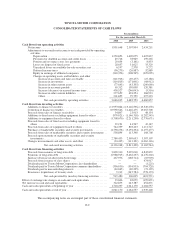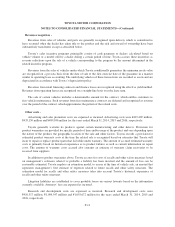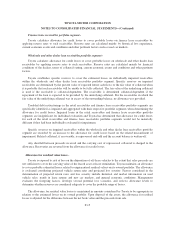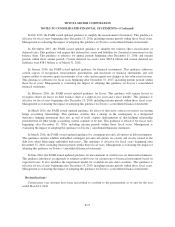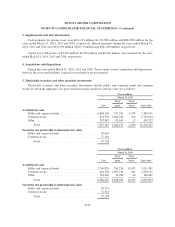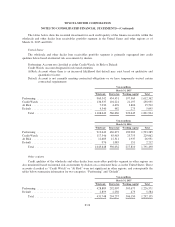Toyota 2015 Annual Report Download - page 155
Download and view the complete annual report
Please find page 155 of the 2015 Toyota annual report below. You can navigate through the pages in the report by either clicking on the pages listed below, or by using the keyword search tool below to find specific information within the annual report.
TOYOTA MOTOR CORPORATION
NOTES TO CONSOLIDATED FINANCIAL STATEMENTS—(Continued)
Interest income on nonaccrual receivables is recognized only to the extent it is received in cash. Accounts
are restored to accrual status only when interest and principal payments are brought current and future payments
are reasonably assured. Receivable balances are written-off against the allowance for credit losses when it is
probable that a loss has been realized. Retail receivables class and finance lease receivables class are not placed
generally on nonaccrual status when principal or interest is 90 days or more past due. However, these receivables
are generally written-off against the allowance for credit losses when payments due are no longer expected to be
received or the account is 120 days contractually past due, whichever occurs first.
As of March 31, 2015 and 2016, finance receivables on nonaccrual status are as follows:
Yen in millions
March 31,
2015 2016
Retail ............................................................. 7,629 8,107
Finance leases ...................................................... 5,562 682
Wholesale ......................................................... 11,573 16,122
Real estate ......................................................... 8,592 16,801
Working capital ..................................................... 446 822
33,802 42,534
As of March 31, 2015 and 2016, finance receivables 90 days or more past due and accruing are as follows:
Yen in millions
March 31,
2015 2016
Retail ............................................................. 28,147 23,419
Finance leases ...................................................... 3,954 3,984
32,101 27,403
Allowance for credit losses -
Allowance for credit losses is established to cover probable losses on finance receivables and vehicles and
equipment on operating leases, resulting from the inability of customers to make required payments. Provision
for credit losses is included in selling, general and administrative expenses.
The allowance for credit losses is based on a systematic, ongoing review and evaluation performed as part
of the credit-risk evaluation process, historical loss experience, the size and composition of the portfolios, current
economic events and conditions, the estimated fair value and adequacy of collateral and other pertinent factors.
Vehicles and equipment on operating leases are not within the scope of accounting guidance governing the
disclosure of portfolio segments.
Retail receivables portfolio segment -
Toyota calculates allowance for credit losses to cover probable losses on retail receivables by applying
reserve rates to such receivables. Reserve rates are calculated mainly by historical loss experience, current
economic events and conditions and other pertinent factors.
F-14







